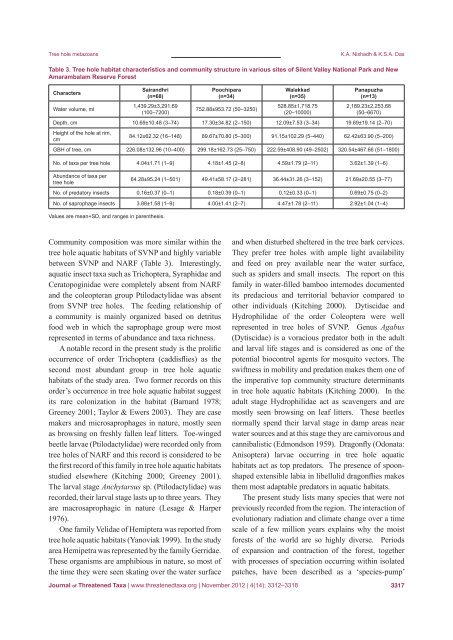View - Journal of Threatened Taxa
View - Journal of Threatened Taxa
View - Journal of Threatened Taxa
Create successful ePaper yourself
Turn your PDF publications into a flip-book with our unique Google optimized e-Paper software.
Tree hole metazoansK.A. Nishadh & K.S.A. DasTable 3. Tree hole habitat characteristics and community structure in various sites <strong>of</strong> Silent Valley National Park and NewAmarambalam Reserve ForestCharactersWater volume, mlSairandhri(n=68)1,439.29±3,291.69(100–7200)Poochipara(n=34)752.88±953.72 (50–3250)Walakkad(n=35)528.85±1,718.75(20–10000)Panapuzha(n=13)2,189.23±2,253.68(50–6670)Depth, cm 10.69±10.48 (3–74) 17.30±34.82 (2–150) 12.09±7.53 (3–34) 19.69±19.14 (2–70)Height <strong>of</strong> the hole at rim,cm84.12±62.32 (16–148) 89.67±70.80 (5–300) 91.15±102.29 (5–440) 62.42±63.90 (5–200)GBH <strong>of</strong> tree, cm 226.08±132.96 (10–400) 299.18±162.73 (25–750) 222.59±408.90 (49–2502) 320.54±467.66 (51–1800)No. <strong>of</strong> taxa per tree hole 4.04±1.71 (1–9) 4.18±1.45 (2–8) 4.59±1.79 (2–11) 3.62±1.39 (1–6)Abundance <strong>of</strong> taxa pertree hole64.28±95.24 (1–501) 49.41±58.17 (2–281) 36.44±31.26 (3–152) 21.69±20.55 (3–77)No. <strong>of</strong> predatory insects 0.16±0.37 (0–1) 0.18±0.39 (0–1) 0.12±0.33 (0–1) 0.69±0.75 (0–2)No. <strong>of</strong> saprophage insects 3.88±1.58 (1–9) 4.00±1.41 (2–7) 4.47±1.78 (2–11) 2.92±1.04 (1–4)Values are mean+SD, and ranges in parenthesis.Community composition was more similar within thetree hole aquatic habitats <strong>of</strong> SVNP and highly variablebetween SVNP and NARF (Table 3). Interestingly,aquatic insect taxa such as Trichoptera, Syraphidae andCeratopoginidae were completely absent from NARFand the coleopteran group Ptilodactylidae was absentfrom SVNP tree holes. The feeding relationship <strong>of</strong>a community is mainly organized based on detritusfood web in which the saprophage group were mostrepresented in terms <strong>of</strong> abundance and taxa richness.A notable record in the present study is the prolificoccurrence <strong>of</strong> order Trichoptera (caddisflies) as thesecond most abundant group in tree hole aquatichabitats <strong>of</strong> the study area. Two former records on thisorder’s occurrence in tree hole aquatic habitat suggestits rare colonization in the habitat (Barnard 1978;Greeney 2001; Taylor & Ewers 2003). They are casemakers and microsaprophages in nature, mostly seenas browsing on freshly fallen leaf litters. Toe-wingedbeetle larvae (Ptilodactylidae) were recorded only fromtree holes <strong>of</strong> NARF and this record is considered to bethe first record <strong>of</strong> this family in tree hole aquatic habitatsstudied elsewhere (Kitching 2000; Greeney 2001).The larval stage Anchytarsus sp. (Ptilodactylidae) wasrecorded, their larval stage lasts up to three years. Theyare macrosaprophagic in nature (Lesage & Harper1976).One family Velidae <strong>of</strong> Hemiptera was reported fromtree hole aquatic habitats (Yanoviak 1999). In the studyarea Hemipetra was represented by the family Gerridae.These organisms are amphibious in nature, so most <strong>of</strong>the time they were seen skating over the water surfaceand when disturbed sheltered in the tree bark cervices.They prefer tree holes with ample light availabilityand feed on prey available near the water surface,such as spiders and small insects. The report on thisfamily in water-filled bamboo internodes documentedits predacious and territorial behavior compared toother individuals (Kitching 2000). Dytiscidae andHydrophilidae <strong>of</strong> the order Coleoptera were wellrepresented in tree holes <strong>of</strong> SVNP. Genus Agabus(Dytiscidae) is a voracious predator both in the adultand larval life stages and is considered as one <strong>of</strong> thepotential biocontrol agents for mosquito vectors. Theswiftness in mobility and predation makes them one <strong>of</strong>the imperative top community structure determinantsin tree hole aquatic habitats (Kitching 2000). In theadult stage Hydrophilidae act as scavengers and aremostly seen browsing on leaf litters. These beetlesnormally spend their larval stage in damp areas nearwater sources and at this stage they are carnivorous andcannibalistic (Edmondson 1959). Dragonfly (Odonata:Anisoptera) larvae occurring in tree hole aquatichabitats act as top predators. The presence <strong>of</strong> spoonshapedextensible labia in libellulid dragonflies makesthem most adaptable predators in aquatic habitats.The present study lists many species that were notpreviously recorded from the region. The interaction <strong>of</strong>evolutionary radiation and climate change over a timescale <strong>of</strong> a few million years explains why the moistforests <strong>of</strong> the world are so highly diverse. Periods<strong>of</strong> expansion and contraction <strong>of</strong> the forest, togetherwith processes <strong>of</strong> speciation occurring within isolatedpatches, have been described as a ‘species-pump’<strong>Journal</strong> <strong>of</strong> <strong>Threatened</strong> <strong>Taxa</strong> | www.threatenedtaxa.org | November 2012 | 4(14): 3312–33183317

















